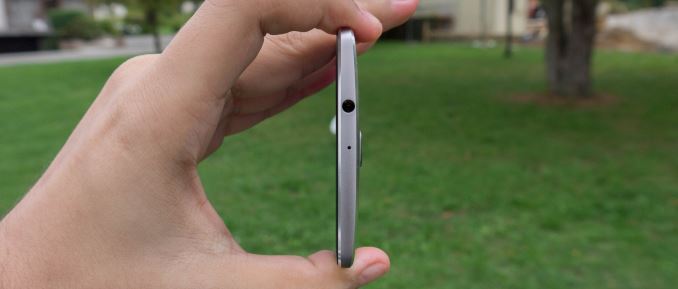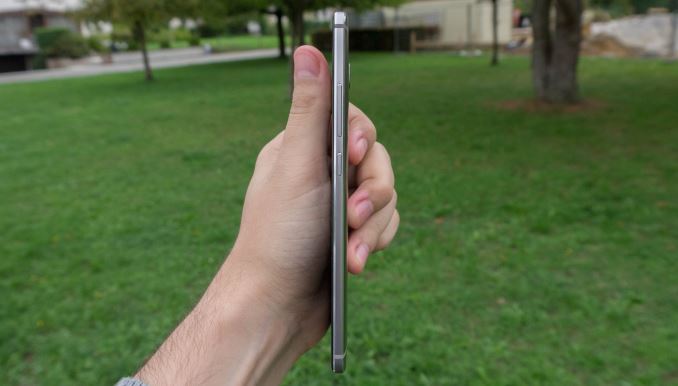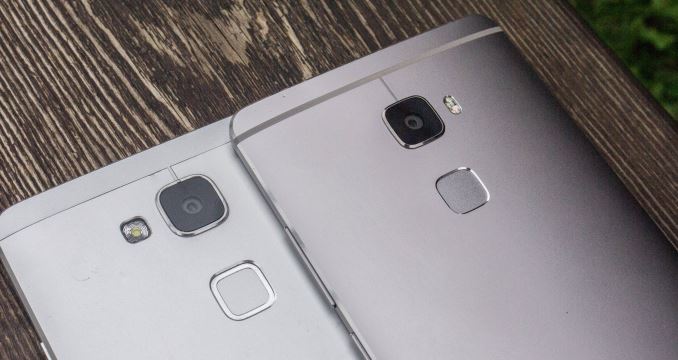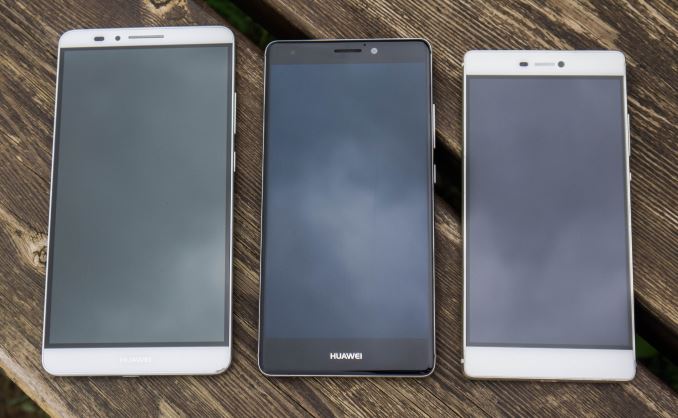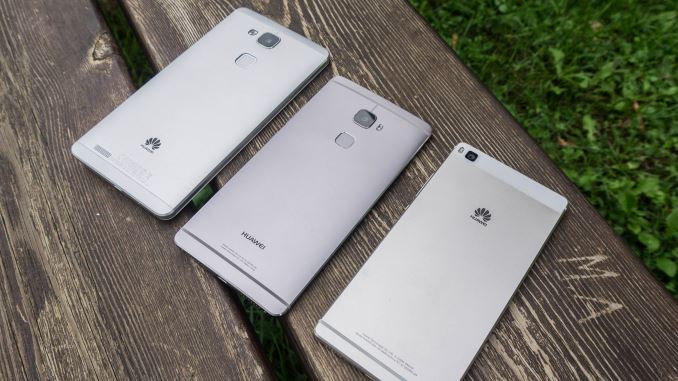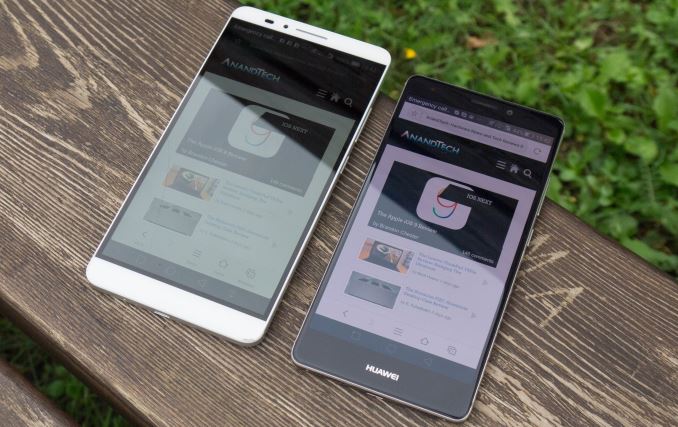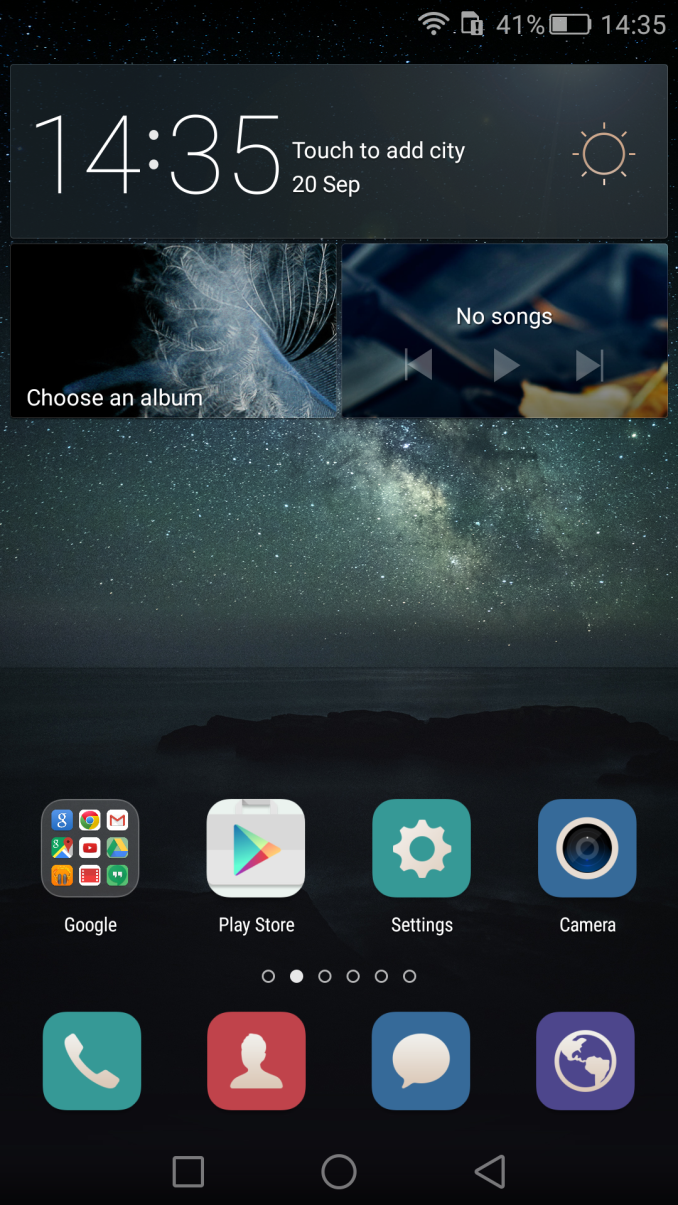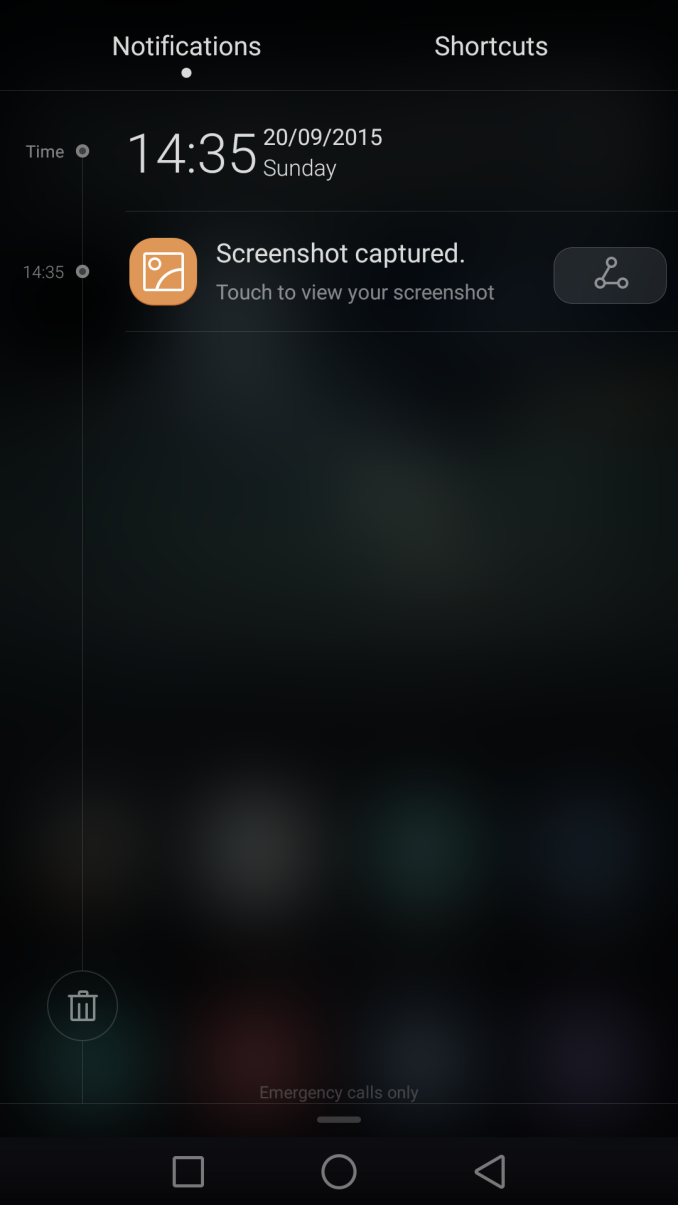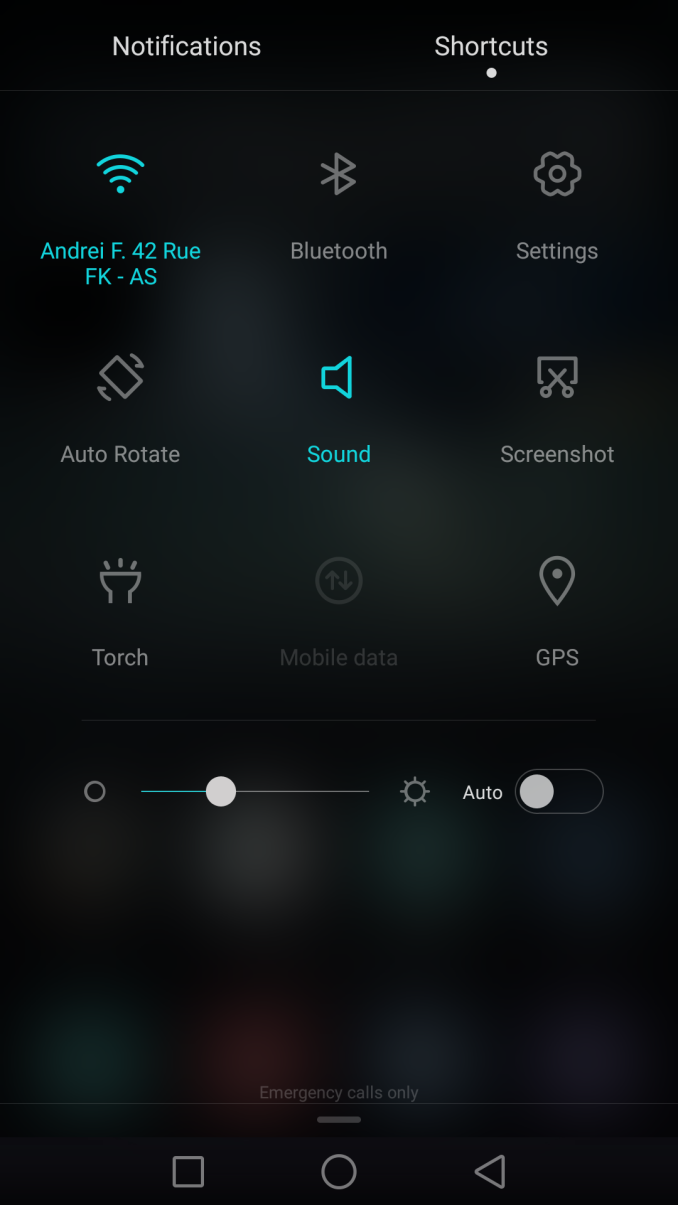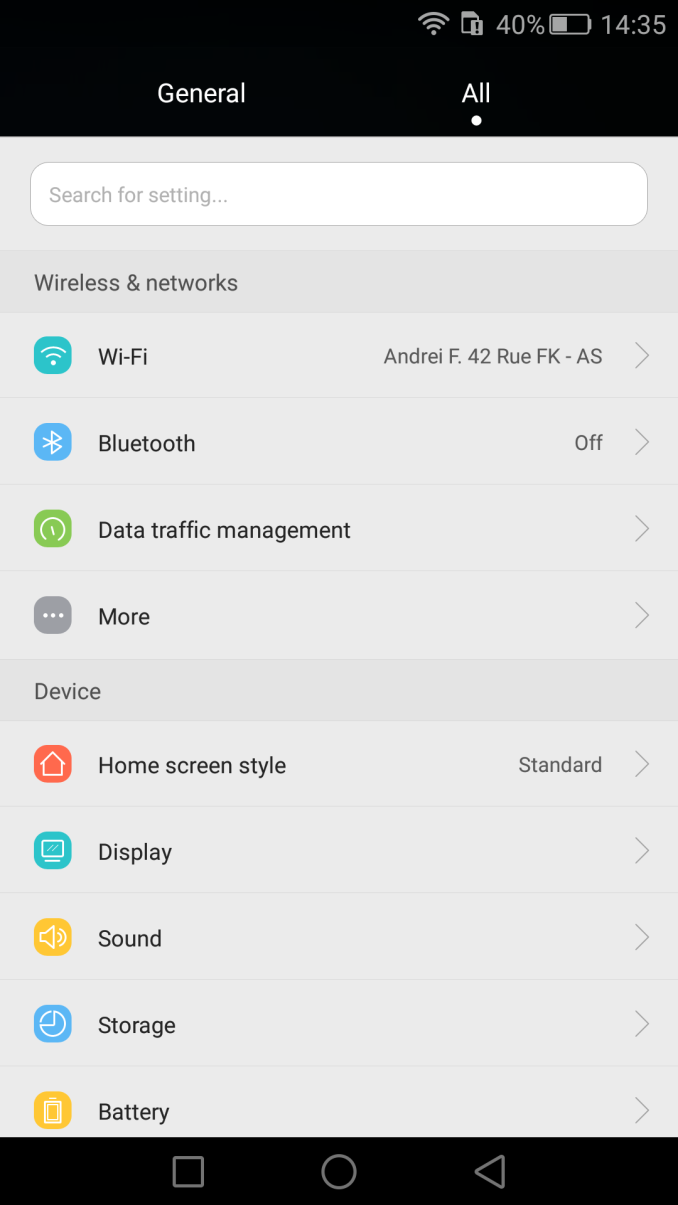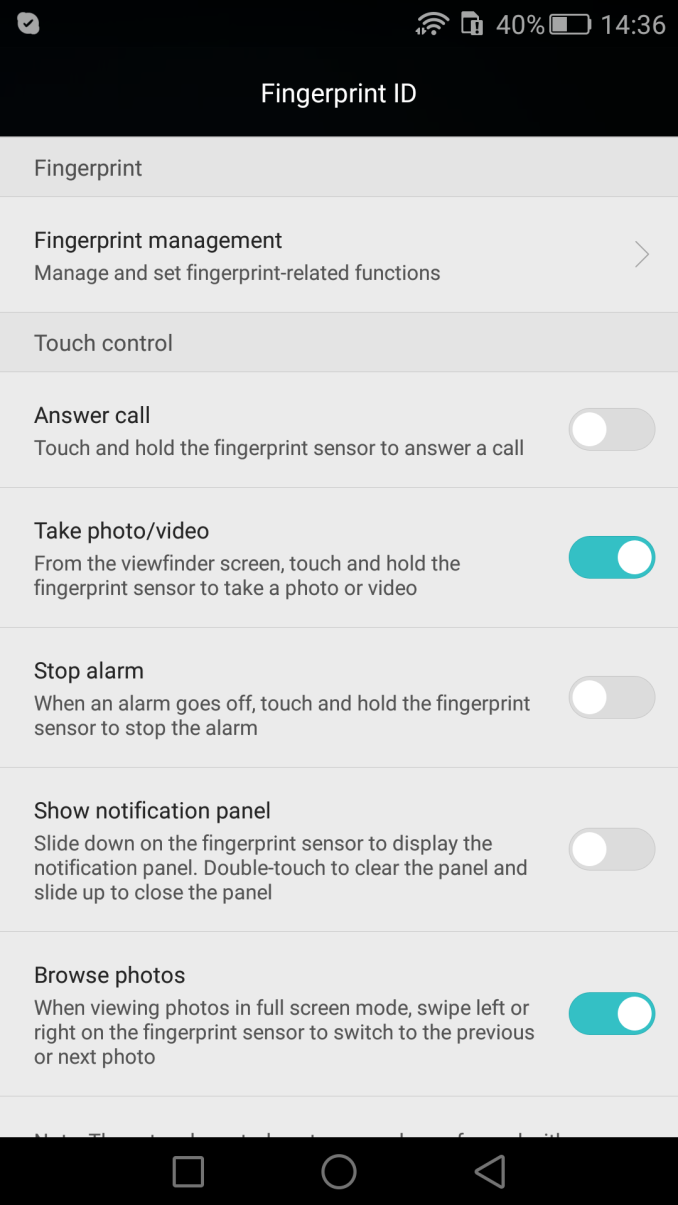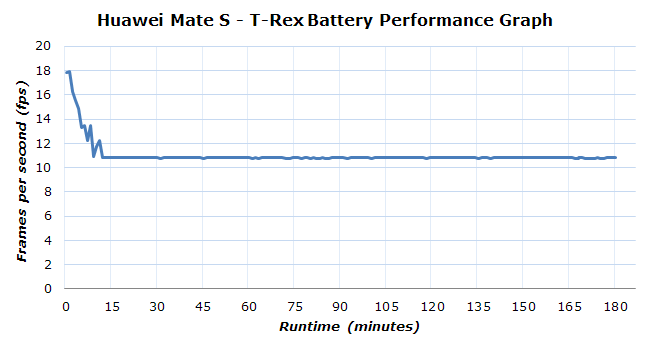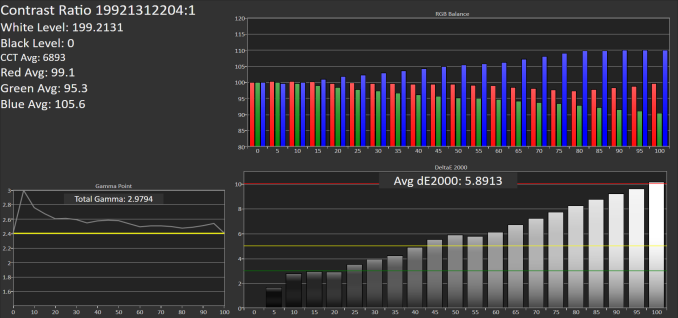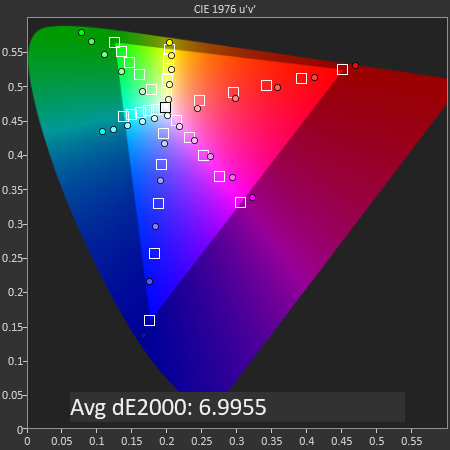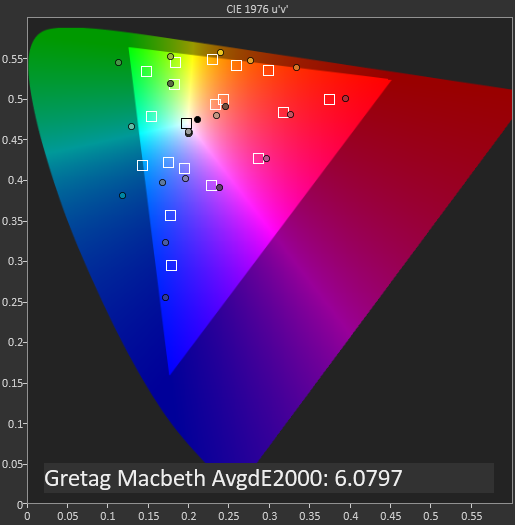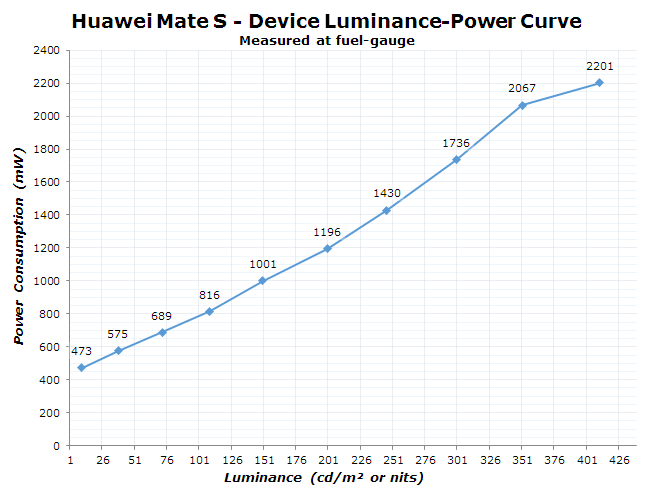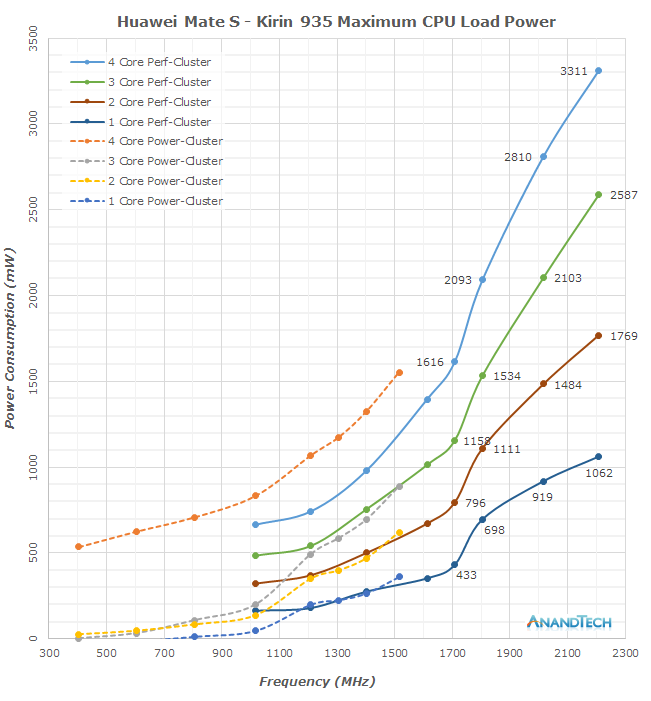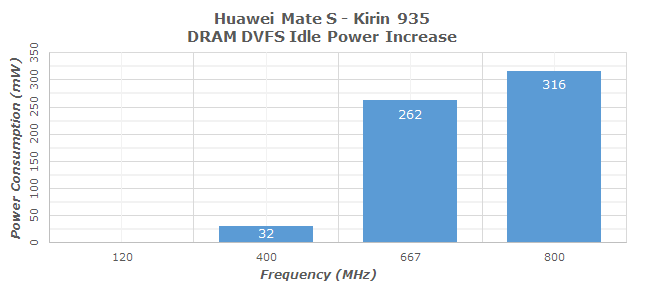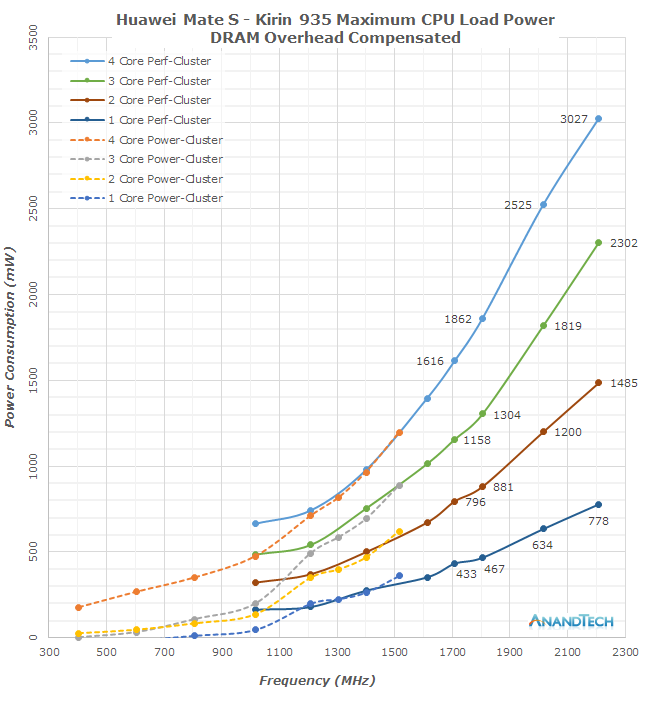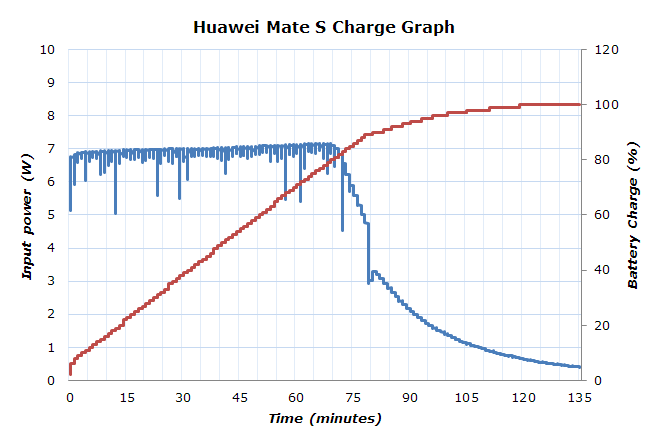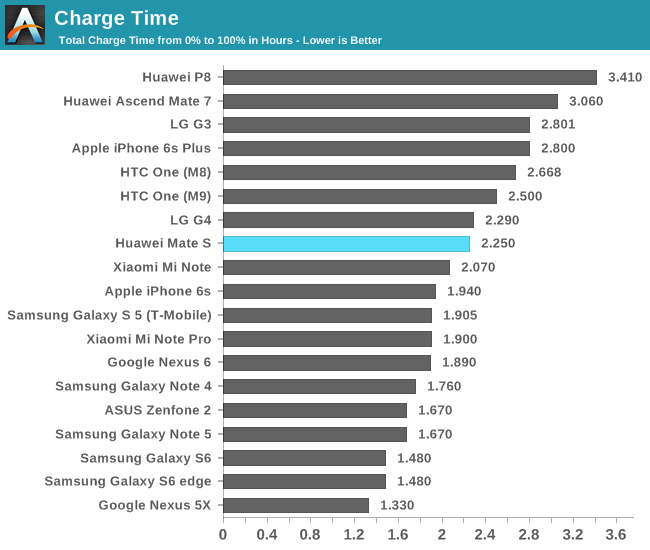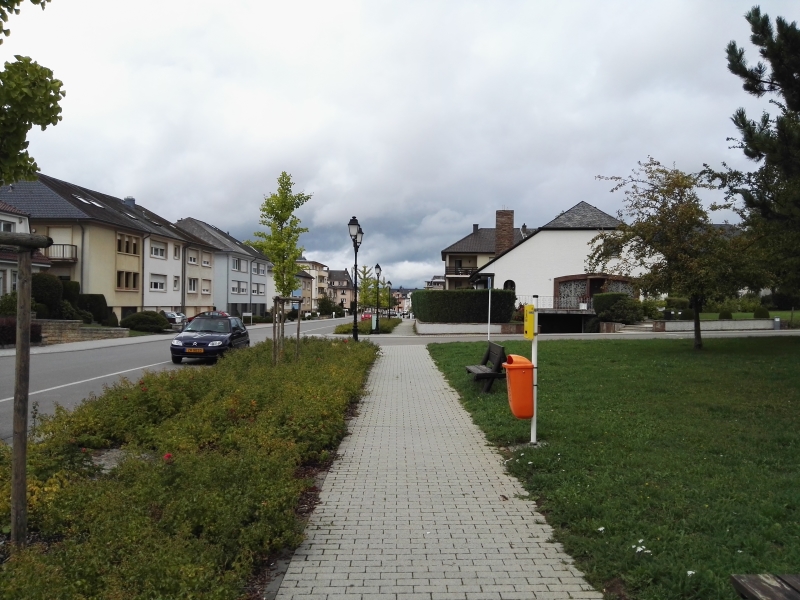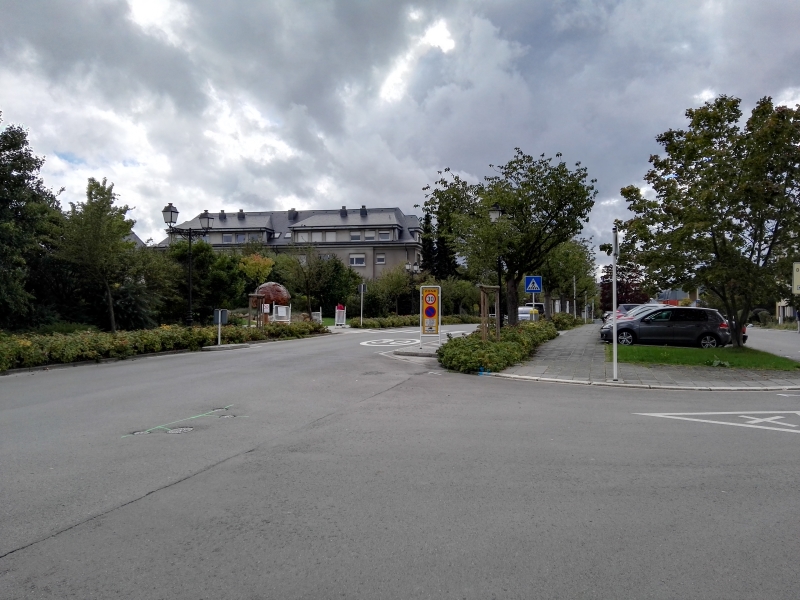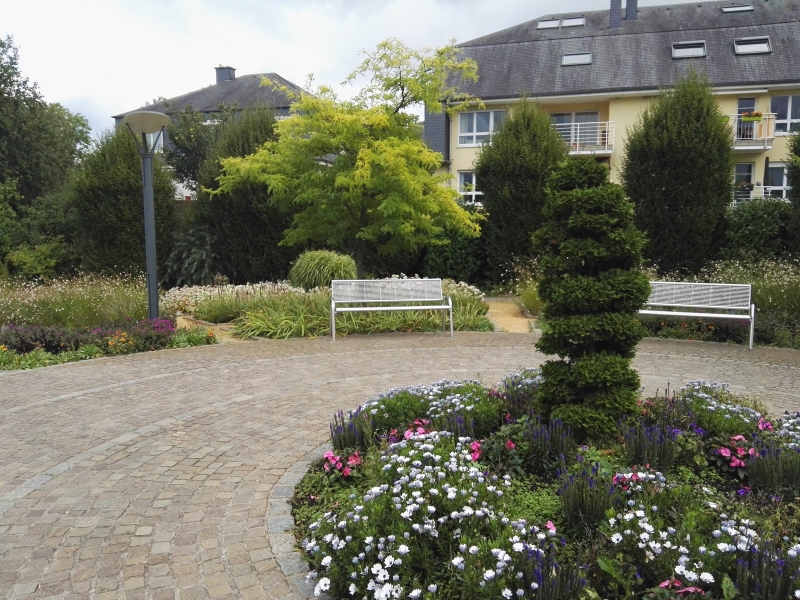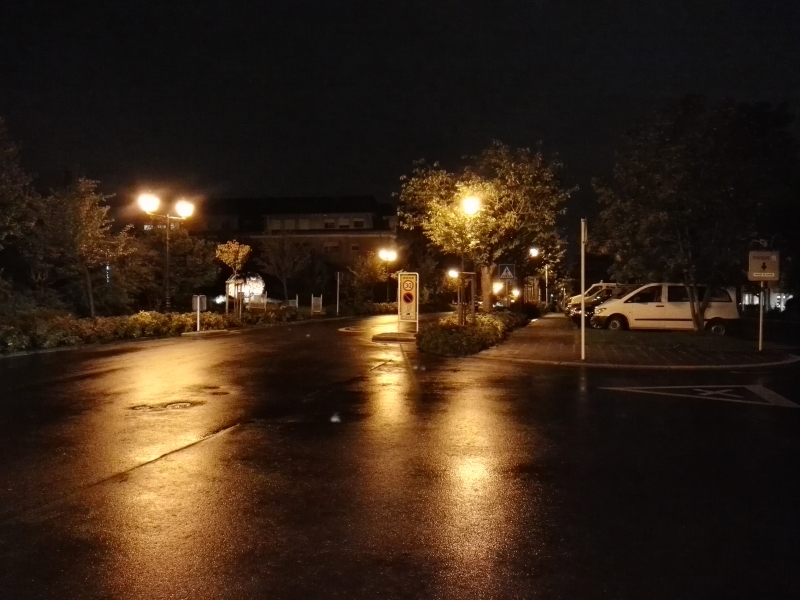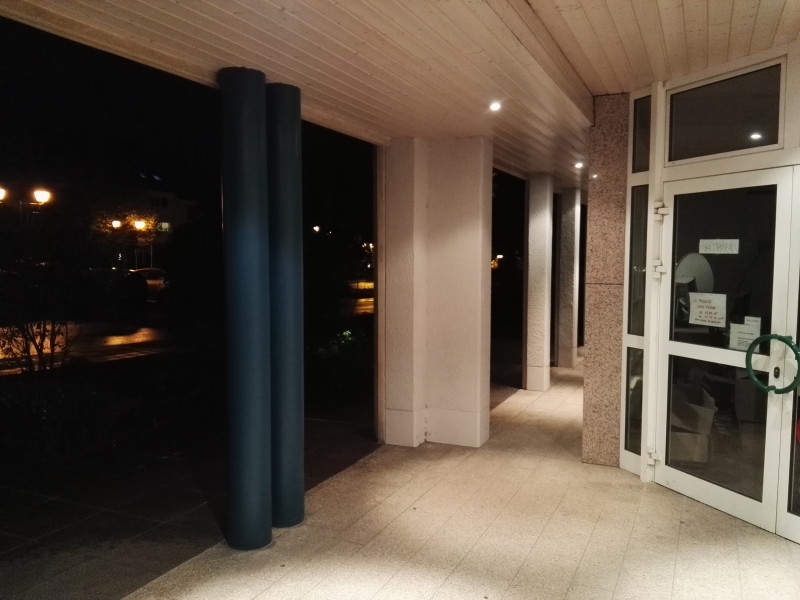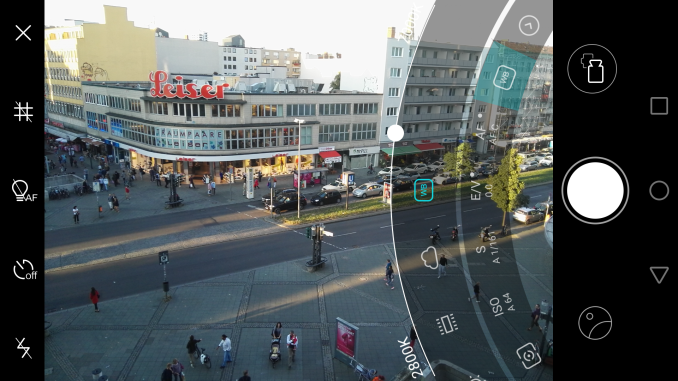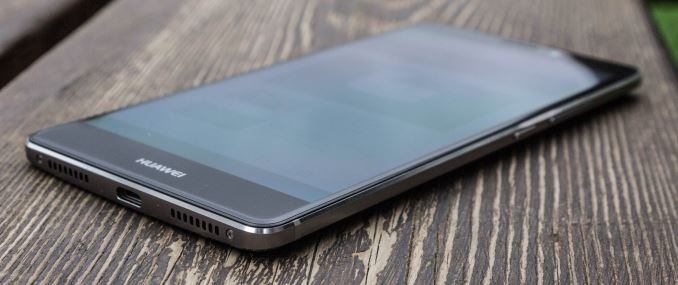
Original Link: https://www.anandtech.com/show/9642/the-huawei-mate-s-review
The Huawei Mate S Review
by Andrei Frumusanu on December 2, 2015 8:00 AM EST- Posted in
- Smartphones
- Huawei
- Mobile
- Kirin
- Mate S

Huawei has been a company which over the past few years has visibly increased its presence in western markets. The Chinese vendor has in particular executed a big push into European markets over the last year as devices have become increasingly available in the usual electronics shops. Following the high-key introduction of the Mate 7 last year, Huawei seems to have settled on a Samsung-like release cadence where we see the smaller P-series introduced in spring and the Mate phablet series in autumn.
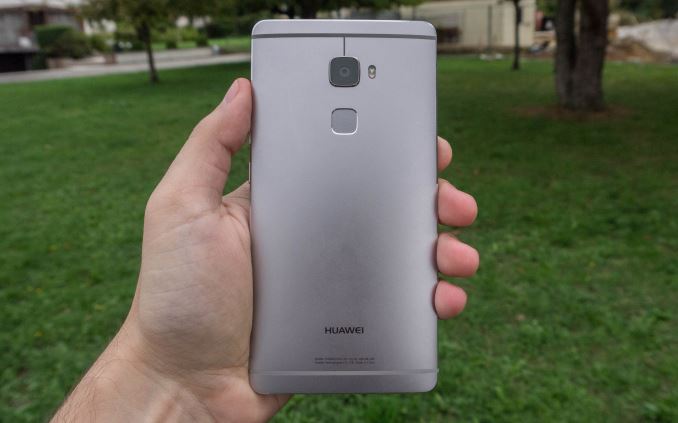
This year Huawei launched the Mate S - not a direct sucessor to the Mate 7, but still clearly a device that continues the design language of the Mate lineup. First up, let's go over the specifications and see what the new hardware provides in terms of upgrades.
| Huawei Mate S | ||
| SoC | HiSilicon Kirin 935 4x Cortex A53@1.5GHz, 4x Cortex A53e@2.2GHz Mali-T628MP4 680MHz |
|
| RAM | 3GB LPDDR3 | |
| Storage | 32GB / 64GB NAND + microSD (128GB in 2016) |
|
| Display | 5.5” 1080p Samsung AMOLED Gorilla Glass 4 + Force Touch in 128GB model (2016) |
|
| Modem | 2G / 3G / 4G LTE UE Category 6 (SoC Integrated HiSilicon Balong Modem) |
|
| Networks (CRR-L09 Model) |
TDD LTE | B40 |
| FDD LTE | B1 / B2 / B3 / B4 / B5 / B7 / B8 / B12 / B17 / B18 / B19 / B20 / B25 / B26 / B28 | |
| UMTS | 850 / 900 / AWS / 1900 / 2100 ( B19 / B8 / B6 / B5 / B4 / B2 / B1) |
|
| DC-42M | B1 / B2 / B4 / B5 / B8 | |
| GSM | 850 / 900 / 1800 / 1900 | |
| Dimensions | 149.8 x 75.3 x 7.2 mm, 156 grams |
|
| Cameras | Rear | 13MP (4160 x 3120) Sony IMX278 Sensor F/2.0 aperture, 29mm eq. w/ OIS |
| Front | 8MP Sony IMX179 F/2.4 aperture, 26mm eq. |
|
| Battery | 2700mAh (10.39 Whr) | |
| OS | Android 5.1.1 (64-bit) EmotionUI 3.1 |
|
| Connectivity | 802.11a/b/g/n 2.4GHz only BT 4.0, microUSB2.0, GPS/GNSS, DLNA, NFC |
|
| SIM Size | NanoSIM + NanoSIM (w/o microSD) |
|
| MSRP | 32GB | 649€ |
| 64GB | 699€ | |
At the heart of the Mate S we find the HiSilicon Kirin 935. This is the same SoC that was found on the basic model Huawei P8 - the Kirin 930, but with the difference that it's clocked 200MHz higher on the faster A53 cluster. As a reminder, we're talking about a two-cluster A53 big.LITTLE design, with instead of using "big" CPU core architectures such as the Cortex A57, we see the use of very high clocked A53 cores coming in at 2.2GHz. The slower A53 cluster comes in at 1.5GHz. The GPU is an ARM Mali T624MP4 clocked in at 680MHz.
The choice of re-using the same SoC as found on the P8 in such a high-end marketed device already leaves us with some doubts about its performance, as we had identified some very worrying performance and efficiency issues with in our Huawei P8 review that seems to stem from the choice of the SoC. Unfortunately it seems HiSilicon and TSMC weren't able to deliver the 16nm Kirin 950 successor in time for this product cycle and the company was only able to integrate the new SoC in the newly launched Mate 8.
The Mate S is the first Huawei device coming with an AMOLED screen. In the past I found that the JDI IPS-Neo screens found in the Mate 7 and P8 to had some rather large shortfalls when it came to viewing angles and backlight bleeding, so seeing Huawei switch over to a Samsung SDI manufatured AMOLED screen is an extremely welcoming change and presents a significant upgrade in screen quality.
The new screen comes in at 5.5" with a resolution of 1080p. Since this is an AMOLED screen, we see use of a diamond PenTile sub-pixel arrangement, but this doesn't seem to pose any problem for the majority of the time.
On the camera side, the Mate S outright adopts the camera system of the P8. This means we again see use of Sony's new RGBW IMX278 sensor in an F/2.0 module with optical image stabilization. The image processing is again handled by a dedicated external ISP provided by Altek. On the front camera, we also find the same IMX179 8MP camera module as on the P8, but this time around there's an added soft-flash / front torch that one can use for better lightning in selfie-shots.
Design-wise, Huawei made some huge strides compared to the Mate 7. While the main characteristics such as the back camera lens and fingerprint sensor underneath it make both devices unmistakably related to each other, Huawei also added a lot of new improvements.
The Mate S ditches the plastic top and bottom antenna covers of the Mate 7 in favour of a full metal-unibody with plastic injected antenna lines. The new model features a new anodized finish that is much grippier than the one on the Mate 7 and feels much more premium.
The speaker has moved from the back to the bottom and now features the same speaker / microphone configuration as on the P8. As a reminder, only the right grill actually has a speaker behind it as the left one is used only for aesthetics and the main microphone.
At 149.8 x 75.3 x 7.2 mm the Mate S is smaller than the Mate 7 in every dimension. The device is by far the thinnest I've come to use as both the rounded back as well as the 2.5D Gorilla Glass 4 front make for a very comfortable and ergonomic grip.
At the top of the front face we find, from left to right, the notification LED, the front LED torch, earpiece, camera, as well as light sensors. I only had the device after a few days after which the earpiece grill got dirty with dust, and due to how fine the grain and the recessed nature of the grill it's extremely hard to clean it so I wish Huawei would have gone with a more classical metallic grill.
The bottom is dominated by a quite large bezel with the Huawei logo, actually a regression over the P8 or Mate 7. The Titanium Grey model with full black front is definitely the best looking variant here as it allows for a seamless transition to the on-screen navigation buttons and perfect black background from the new AMOLED screen.
Overall I was very impressed with the build quality of the Mate S. This is by far Huawei's most premium device to date and I consider it to be even among one of the best built and solid smartphones I've used. There is little to critique about the Mate S's looks, and I would welcome Huawei to continue their current design language in future devices.
Software UX
On the software side, we continue to see usage of Huawei's Android skin, EmotionUI 3.1. We've had a more in-depth look into EmotionUI in our review of the Huawei P8. As the Mate S comes out only a few months after the P8, we see little to no changes in terms of user-interface as both devices run the same software version.
In terms of design, I didn't mind that Huawei didn't introduce any major updates to the UI. I personally like EmotionUI's design language and I'm especially fond the black-accentuated version that comes with the P8 and Mate S. Unfortunately the lack of any update in the UI also means that the Mate S comes with some of the same negative shortcomings that I critiqued on the P8, such as the very unpractical paginated task-switcher interface or Huawei's odd handling of application memory management and its aggressive task-killer.
Where the Mate S differs from the P8 is of course the inclusion of the finger-print sensor. The Mate 7 was one of the first Android devices to introduce a non-swipe fingerprint reader and the Mate S' fingerprint reader improves on its predecessor by increasing both the speed and accuracy of the scanning, making it one of among the best implementations out there.
Huawei takes advantage of the fingerprint reader in ways that larger vendors such as Apple and Samsung fail to do: It actively uses the fingerprint scanner as a capacitive button / track pad that recognizes touches as well as swipes. A useful feature that seems very natural to use is the dropping-down of the notification shade when you swipe down on the fingerprint-reader. Another function is the possibility to navigate between images in the stock gallery by swiping left or right on the scanner.
GPU Performance
Since the Mate S comes with the same Kirin 93X chipset as the P8, we're not expecting any breakthrough performance of the new flagship. The Mali T628MP4 in the Kirin 935 runs at the same 680MHz speed that we've seen it running in the Kirin 930, and we have the same 800MHz LPDDR3 memory on board the Mate S.
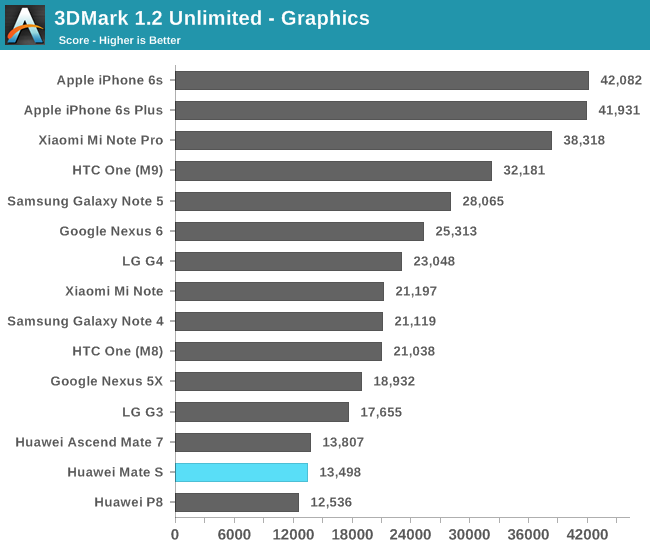
Starting with the 3DMark Unlimited graphics score, we see the Mate S perform slightly better than the P8. This might be due to the increased CPU frequency or a side-effect of the newer r5p1 over r5p0 drivers on the Mate S.
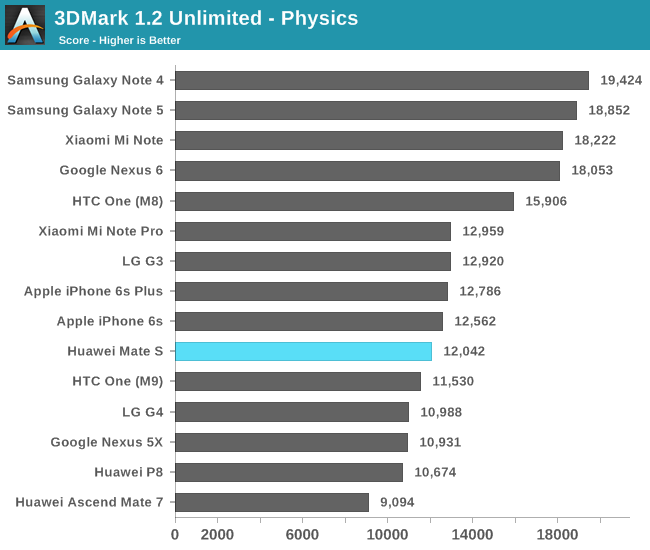
The physics test in 3DMark is mostly a CPU test and here we see results as expected with the increased CPU frequency bringing in about 12% improvement when compared to the P8. Unfortunately the little A53 cores can't keep up with the more powerful CPU architectures found in other devices in our list.
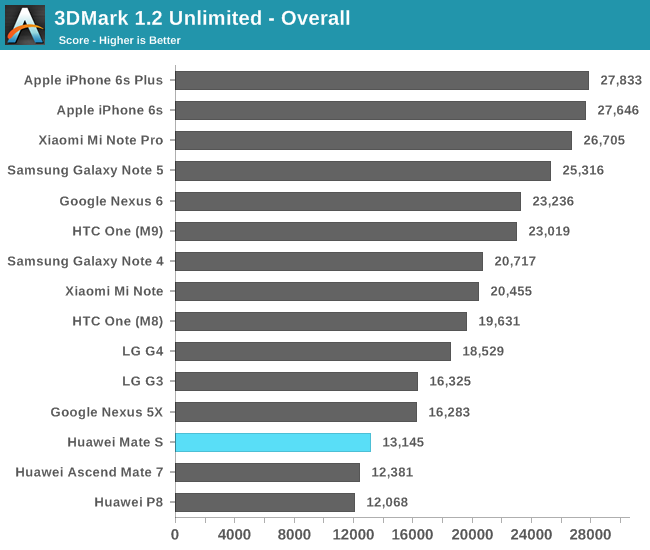
Because of the weak GPU, the Mate S again finds itself among the worstp performing devices, next to the P8 and last year's Mate 7.
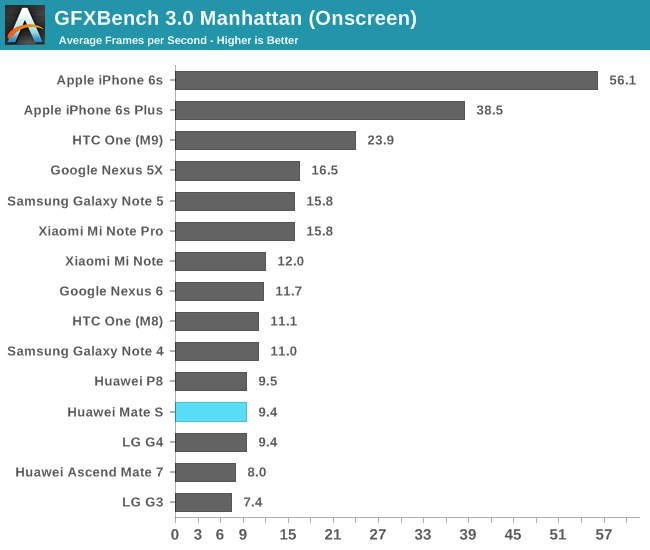
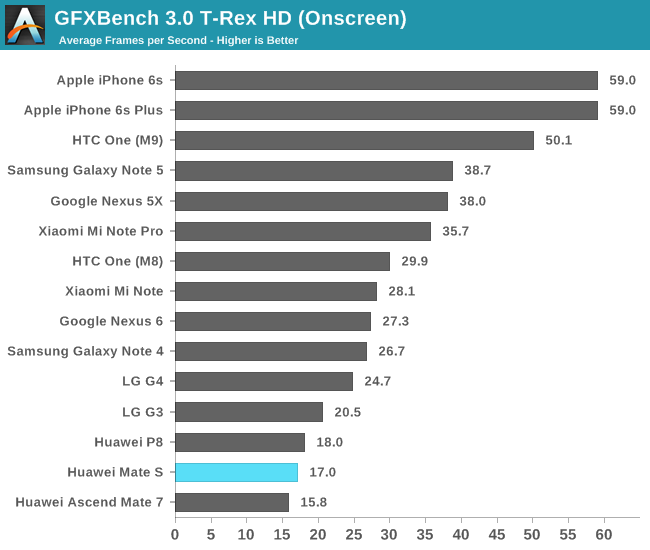
Moving onto GFXBench, we see a similar picture as the Mate S ends up among the worst performing high-end devices released in the last 18 months.
In the review of the P8, I complained about the throttling behaviour of the Kirin 930 and unfortunately that's again something that the Mate S adopts. It seems the Mate S has only slightly better thermal characteristics as the device sits tight at 11fps for the whole duration of the battery rundown after reaching its maximum throttling level.
NAND Performance
Our review device came in with a 32GB SanDisk eMMC NAND module. On Android devices we test NAND performance by using AndroBench. To test sequential reads and writes, we use 256KB buffers executed on a single thread.
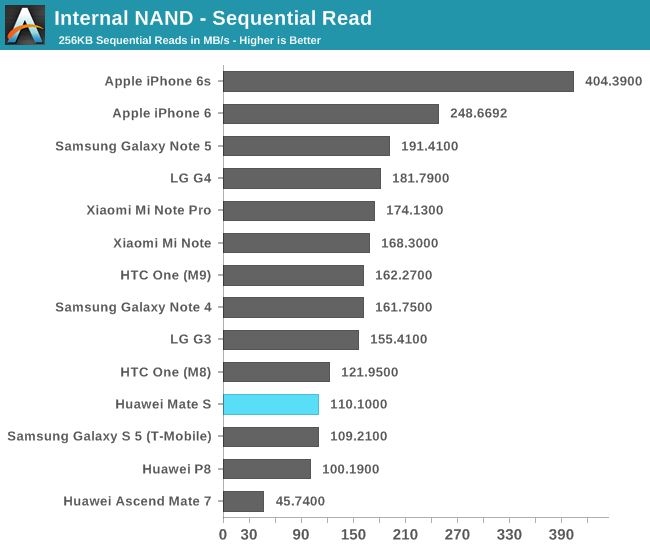
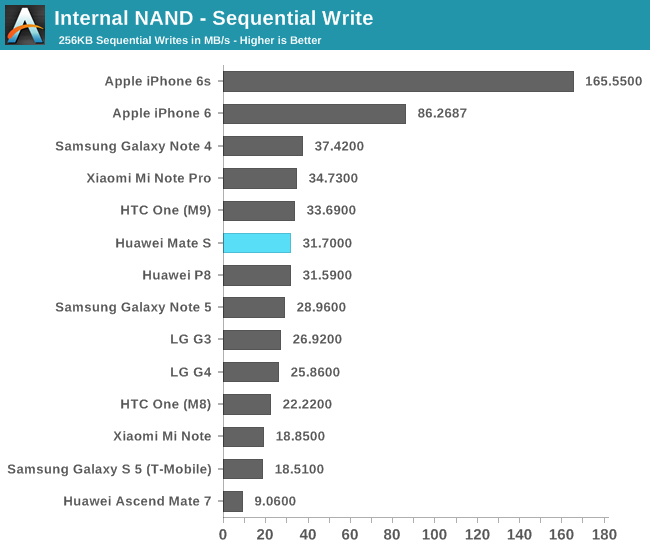
The NAND on the Mate S seems to be a slight improvement on the one found on the P8. The read and write speeds are acceptable but unfortunately also nothing to write home about. It seems the Mate S employs a similar eMMC chipset as the P8 as the results fall within the same performance region.
System Performance
The Mate S's Kirin 935 is an octa-core big.LITTLE SoC with Cortex A53's employed in both clusters. The faster cluster clocks in at 2.2 GHz, representing a theoretical 10% increase in performance over the Kirin 930 in the P8. We expect the same limitations in performance as found on the P8, as even at such high clocks, ARM's in-order CPU architecture meant for power efficiency just isn't powerful enough to compete with the larger cores found in competing flagship devices.
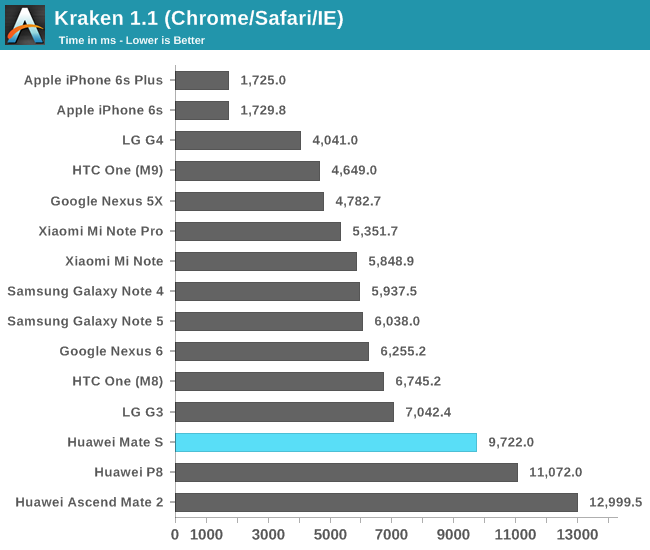
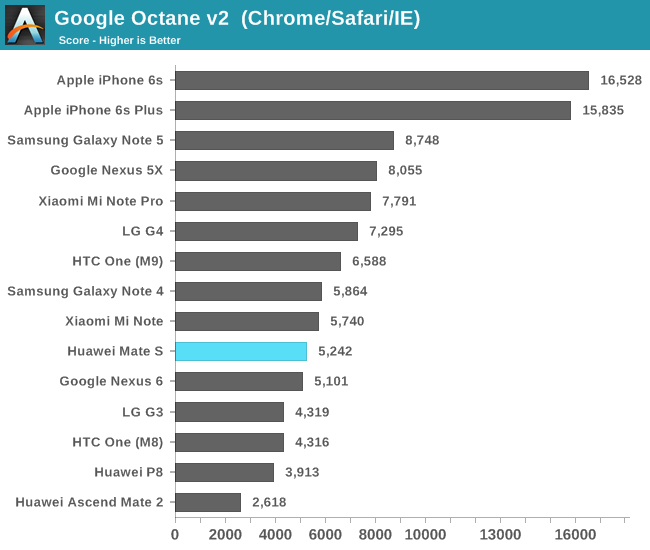
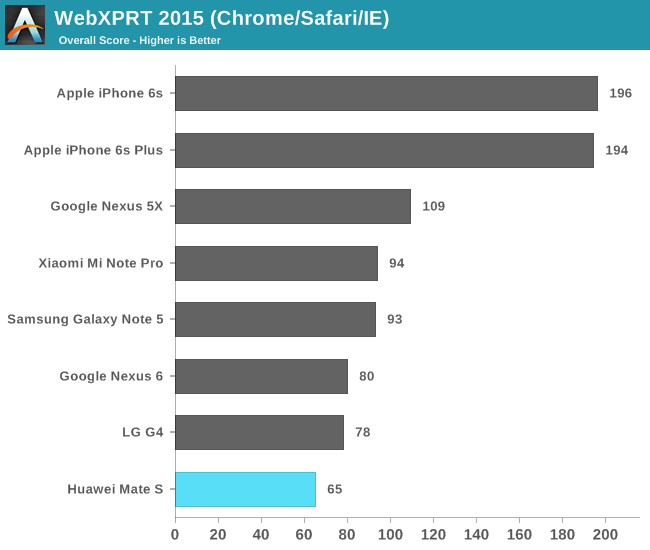
In Kraken and Octane, we discover the expected performance improvement due to the increased clocks. Also as expected, we don't see the Mate S being able to compete with more powerful SoCs. It's interesting to see the A53 inching in on Qualcomm's Krait-based SoCs in some of the tests, this is due to the fact that the Krait architecture's IPC isn't all that higher than an A53 but manages to perform well due to the high clock speed.
Next we move on to PCMark, FutureMark's Android benchmark suite. I've actually been quite happy with PCMark as a benchmark as it's one of the rare benchmark tools out there which actually do manage to deliver on their promise of being representative benchmarks.
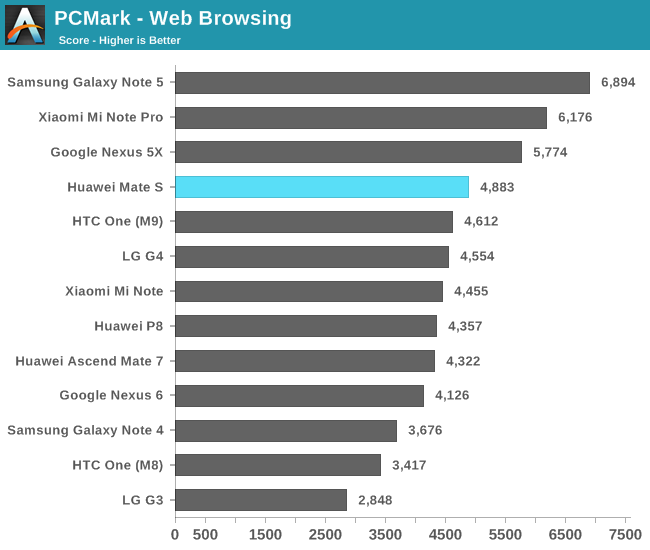
Starting with the web browsing sub-test, the Mate S doesn't end up all that badly. This is due to web-browsing being rarely able to trigger full performance states of more advanced SoCs. Instead it's more about burst loads where latency is more important, and here Huawei's HMP scheduler and CPU governor on the big cores is set up aggressively to directly take advantage of the maximum 2.2GHz performance state where as other devices would scale up more conservatively (And thus might miss the critical load time-window).
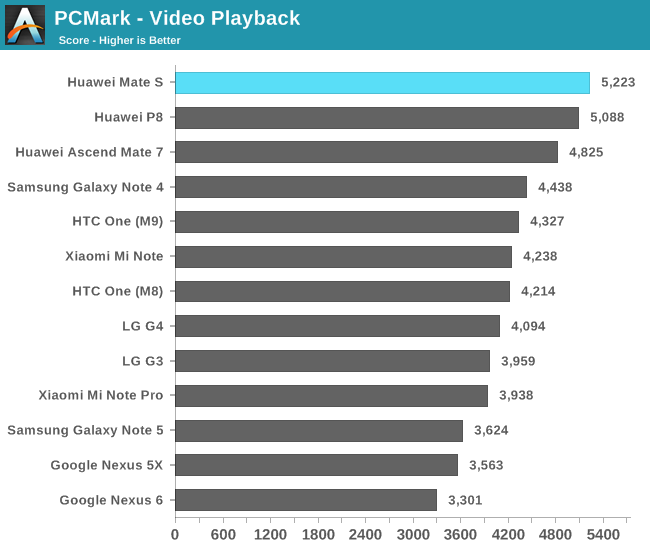
The video sub-test is a test of the hardware decoder latency and performance as well as NAND storage performance as the video test quickly seeks through the test video. The Mate S, similarly to the P8, performs very well here. Oddly enough we've seen a large degradation in performance with a lot of devices when they switched over from KitKat to Lolipop, but it seems Kirin SoCs were not affected by this OS degradation.
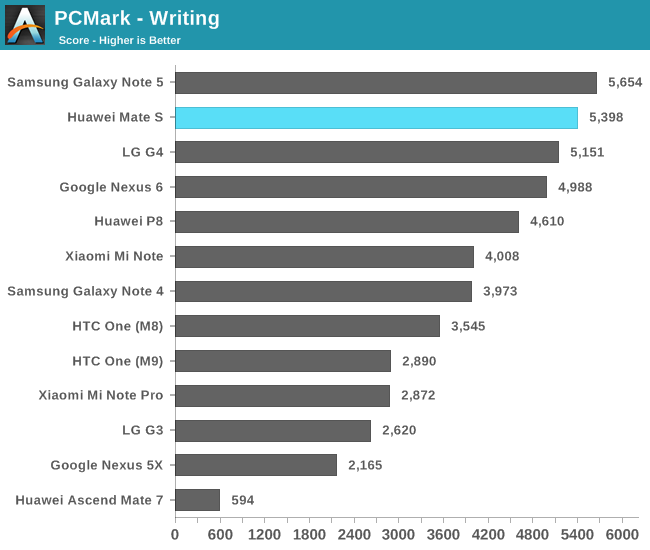
The writing sub-test is again an interesting sub-test as it's extremely sensible to optimizations of the Android virtual machine. We've seen some large jumps in performance across many devices when 5.0 Lolipop introduced ART (Android RunTime) over a year ago. The Mate S here again performs well in the benchmark due to the fact that even though its maximum performance lays well under competing devices such as the Note 5, it's still able to hold up its own its own thanks to the very aggressive DVFS scaling of the big CPU cluster.
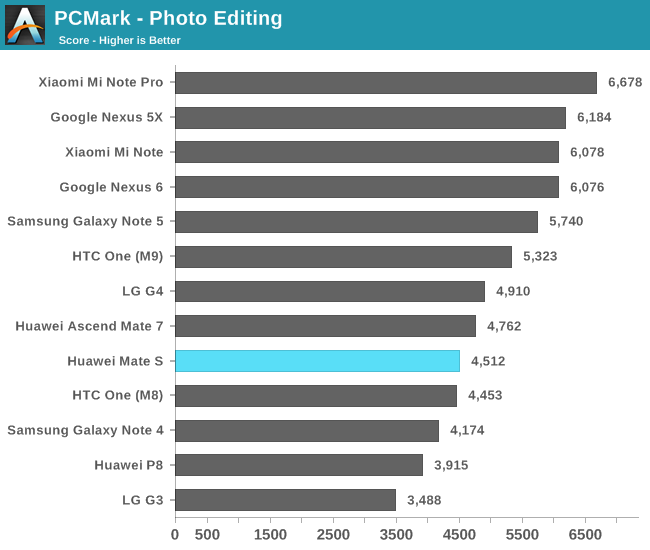
The Photo test is a computational performance test that takes advantage of RenderScript and thus, if the driver allows it, is able to offload loads onto the GPU. The Mali T628MP4 of the Kirin 935 performs adequately but can't compete against the larger Snapdragon and Exynos configurations. It's nice to see that the Mate S performs better than the P8 here, something that may be attributed to newer Mali drivers on the Mate S.
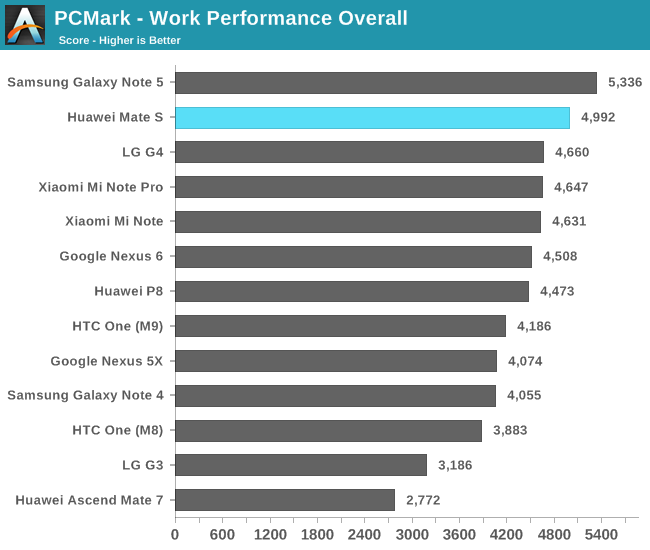
Overall, the Mate S's performance in PCMark ends up quite high. And this is mostly true for every-day performance of the device as it's only on web-page rendering or on application loadings where you do notice that it is slower than competing devices.
We move on to Basemark OS II 2.0, another benchmark that is supposed to test overall system performance.
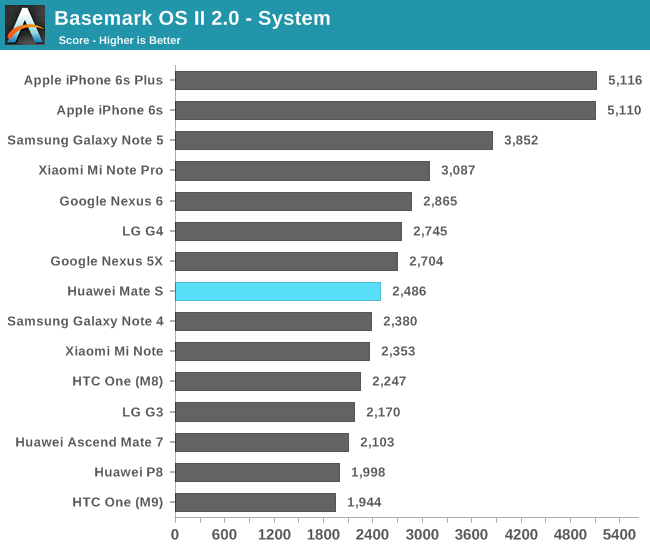
In the System sub-test the Mate S falls inbetween devices which use A57 CPUs such as the Snapdragon 810 and Exynos 7420, and older Krait or A15-based devices. Basemark's system test is much more limited by raw performance of the SoC and thus represents more heavy workloads. It's interesting to see though that the 2.2GHz A53s are still able to hold up against the competition, and the Mate S manages to perform 25% better than the P8, meaning Huawei was able to squeeze out more performance through software optimizations like modifications to the CPU frequency governor.
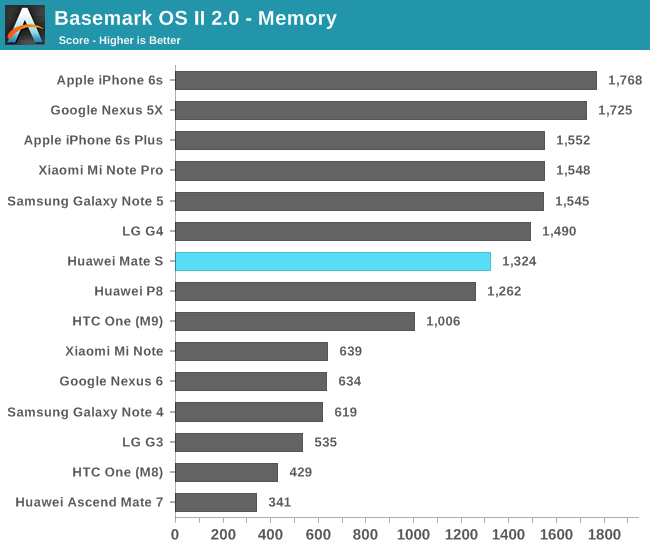
The memory test in Basemark is supposed to be a realistic NAND test on how applications would be affected by storage performance. Again due to the similar eMMC employed, the Mate S ends up close to the P8, and actually not that far off from higher-end flagship devices.
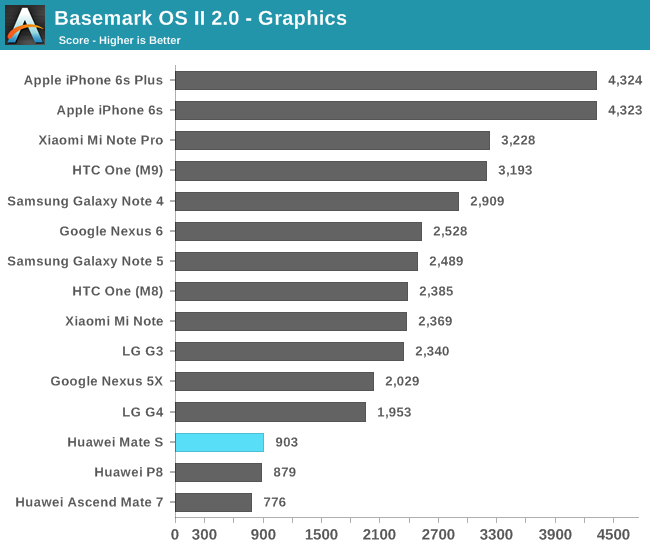
Basemark OS graphics test seems to be very sensitive to Mali GPUs and causes them to perform rather poorly. All recent HiSilicon SoCs end up at the bottom of the chart in this test.
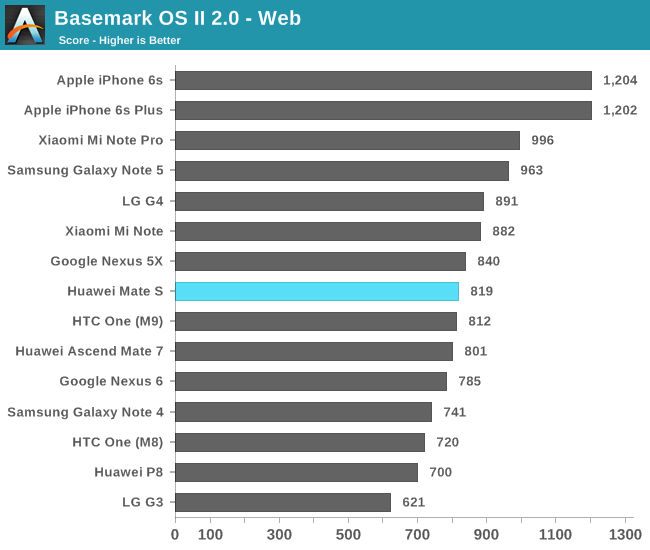
In the web test the Mate S again falls inbetween the more powerful SoC devices and devices from the previous generation. Again, we see the Kirin 935's clock increase and modified DVFS mechanism help it edge out the P8.
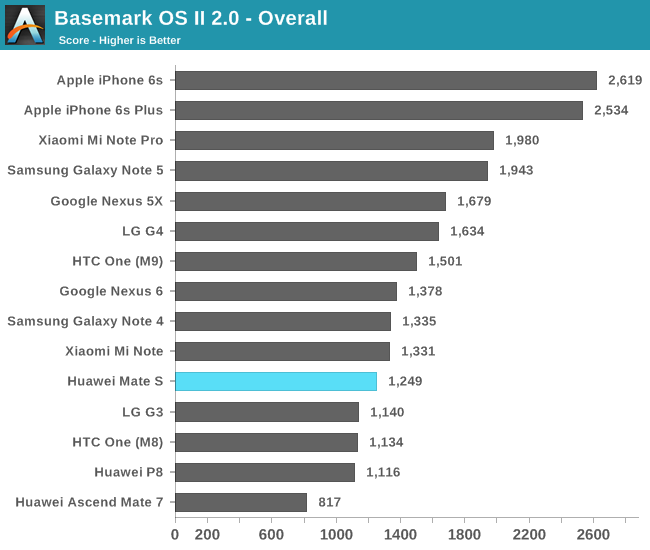
Again due to the sub-standard GPU scores the overall Basemark OS score for the Mate S ends up towards the lower-end of the spectrum.
All in all, the Mate S' daily performance is satisfactory but one shouldn't expect it to be able to keep up with devices with more powerful CPU architectures. I feel like I'm repeating myself here but unfortunately 2015 has been a quite disappointing year in terms of performance advancements for Android devices. Except Samsung and Apple, it seems all other vendors seem to have been forced to come up with sub-par solutions in order to satisfy marketing demands. Both HiSilicon and MediaTek were caught pants-down as they had to rely on rely on A53 designs to power their flagship SoCs, while Qualcomm wasn't able to properly execute their A57 Snapdragon SoCs.
Display Measurement
A big part of the story behind the Mate S is the inclusion for the first time Samsung AMOLED screen instead of an traditional LCD panel. Screen quality was in my experience one of the weak-points of Huawei devices. Both the Honor 6 and Mate 7 I reviewed suffered from quite disappointing viewing angles and the P8 review sample I received added in bad backlight bleed into the list of faults with the screens.
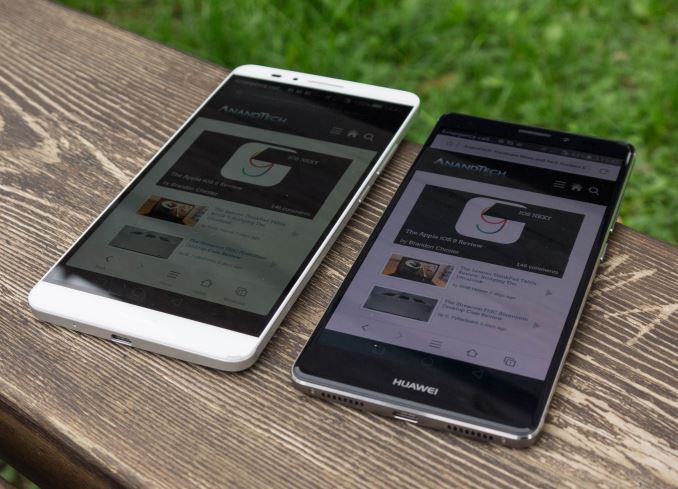
The Mate S is a large departure of Huawei devices of the past as the inclusion of the new AMOLED screen basically eliminates viewing angle issues as well as build quality issues leading to uneven backlight illumination. Huawei also uses a Samsung display driver IC (DDIC) that uses panel-self-refresh, a must in any of today's smartphones.
We start by measuring the maxium brightness of the Mate S. As always, our display testing is done with an X-Rite i1Pro 2 spectrophotometer as our measurement hardware, in conjunction with SpectraCal's CalMAN software suite and our own workflow to be able to get an accurate display characterization.
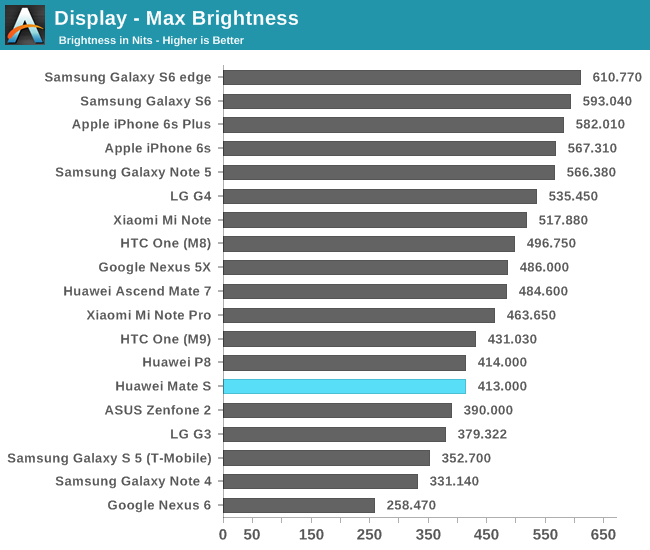
During my intial hands-on with the Mate S I noticed it got quite bright in comparison to usual manual brightness of other AMOLED devices. Indeed, the Mate S is able to go up to 413 cd/m² while traditionally Samsung devices don't exceed 330-350 nits unless you enable auto-brightness in bright lightning conditions. Unfortunately the auto-brightness mode of the Mate S doesn't enable similar boosts so the maximum manual setting on the Mate S is also the maximum the device supports.
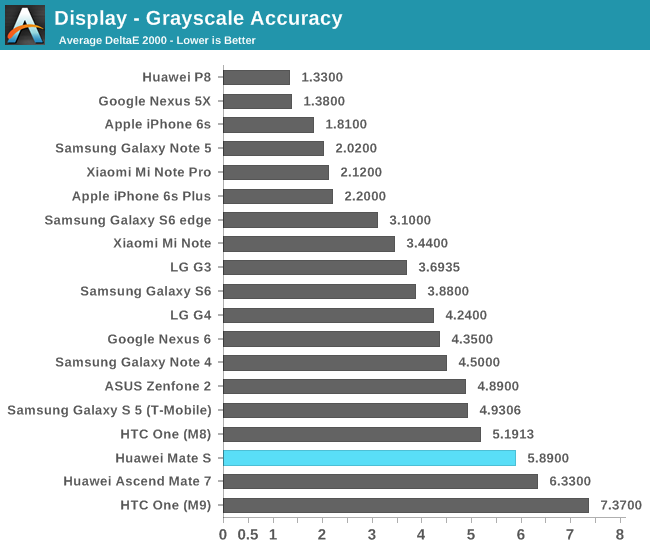
Next, we move to greyscale accuracy testing. Here we see that the Mate S suffers from slight blueish tones as the average colour temperature ends up at 6893K. The dE2000 deviation increases with white value ending up with a total gamma of 2.9 instead of the 2.2 target.
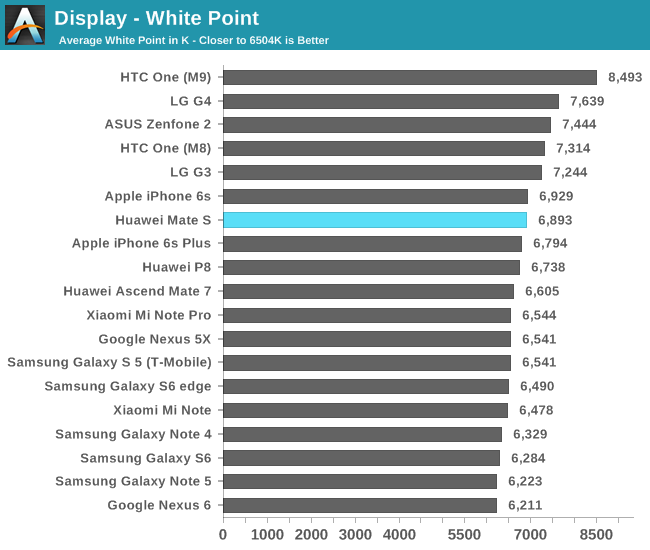
This is rather unfortunate as it had praised the P8's colour accuracy once you set it to minimum colour temperature in the display settings. The Mate S seems to confirm that this was just a one-off coincidence for Huawei as the Mate S's colour temperature slider isn't able to compensate for the bad accuracy results even when I try to hit 6500K with it.
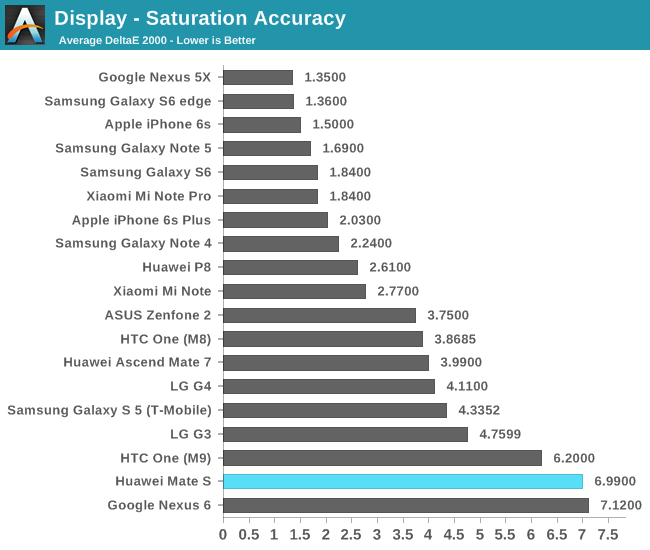
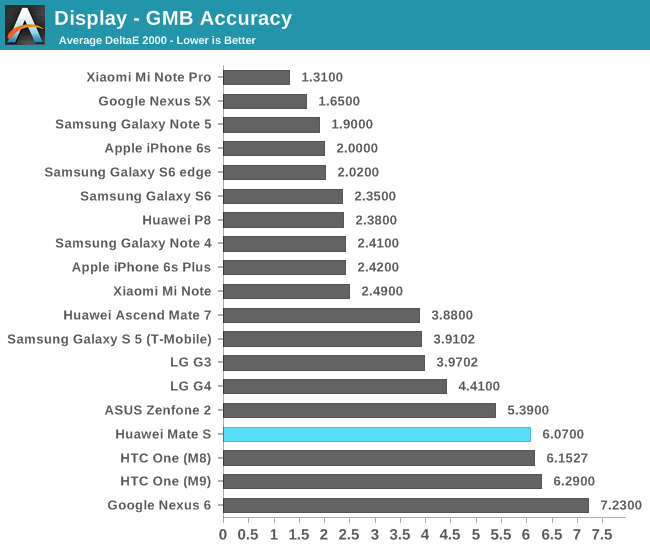
While the Mate S's AMOLED screen represents a large improvement in terms of overall screen quality such as viewing angles and luminance homogenity, it's absolutely not a display that can be considered colour accurate. For people who do not put too much weight into colour accuracy, the vibrant and constrast-rich display might actually be a positive characteristic. In general, the Mate S screen choice does improve over past Huawei devices so it'll definitely be interesting to see how the company will go forward with future devices.
Display Power
We see the Mate S's base power consumption at full black fall in at around 450mW. If accurate, this would fall in around the base power consumption of the Note 4 Exynos. The power here is attributed mostly to various device components such as SoC, DRAM, PMIC and most importantly the DDIC. As the Mate S is only a 1080p device, this is a somewhat disappointing figure but could easily be compensated by an efficient panel.
Unfortuantely, it seems that the Mate S isn't efficient. At 200 cd/m² the Mate S consumes about 769mW of power that can be attributed alone to the increase in luminosity. At maximum brightness, this goes up to 1.75W of screen-power for a total device power of 2.2W. As one can notice in the graph, there's a weird non-linear increase in power for the last measurement point. I investigated this and discovered that at maximum brightness, the screen isn't actually uniformely bright and some parts top off at around ~360 nits while others went to the maximum reached ~410 nits.
| Screen Luminance Power Efficiency 100% APL / White |
||||||
| Device | Screen Luminance Power at 200cd/m² |
Luminance Power (mW) / Screen area (cm²) Efficiency |
||||
| LG G4 | 354 mW | 4.11 | ||||
| Meizu MX4 | 345 mW | 4.14 | ||||
| Huawei P8 | ~341 mW | ~4.43 | ||||
| Meizu MX4 Pro | 386 mW | 4.47 | ||||
| Samsung Galaxy Note 5 | 504 mW | 5.64 | ||||
| Samsung Galaxy S6 | 442 mW | 5.99 | ||||
| Samsung Galaxy S5 | 532 mW | 7.21 | ||||
| Samsung Galaxy Note 4 | 665 mW | 7.22 | ||||
| Samsung Galaxy S5 LTEA | 605 mW | 8.20 | ||||
| LG Flex 2 | 765 mW | 8.89 | ||||
| Samsung Galaxy S4 | 653 mW | 9.22 | ||||
| Huawei Mate S | ~769 mW | ~9.24 | ||||
A few months ago we published a look at AMOLED power efficiency numbers of Samsung Galaxy devices. Since then, I've been able to add in a few more devices to get a better view of overall screen efficiencies. I also decided to present efficiency in mW per cm² of screen area instead of normalizing efficiency values for a certain screen size as I did last time, so this time we have some better concrete values representing real-world physics.
The Mate S falls in extremely close to the efficiency of the Galaxy S4's screen. This is rather unfortunate for a 2015 device as as we can see in the table AMOLED technology has made very large efficiency improvements since then. In fact the Note 5 is currently the most efficienct AMOLED to date and is able to show off a whole 38% better luminance efficiency than the Mate S screen. What is more shocking though is that this represents an over 100% decrease in efficiency when compared to LCD devices such as the P8.
I wish Huawei would have opted for a more efficient AMOLED emitter choice instead what seems to be a cheaper alternative, as this will definitely have an impact on the device's battery life.
CPU Power Consumption
While usually I'd jump over immediately to our battery benchmark scores after putting into context the device's screen power consumption, this time I wanted to take some time to expose and answer some of the unanswered questions in regards to the Kirin 93X's power behaviour. In the review of the P8 I noticed that there was an extremely unusual jump in power consumption when going from idle to full load of one CPU core. I was a bit perplexed by this but ended up blaming it on leakage of the SoC and non-CPU cluster such as maybe the L2.
For the Mate S I went ahead to root it and characterize the power curves. Again, I'd like to mention that this is done via the internal fuel-gauge so the numbers are not as accurate as the figures we published in other deep dives where I measure it externally via a precision energy meter. The little cluster figures in particular should be taken with a grain of salt as the lower frequencies are affected by margin of error of the measurement method.
As long as we're still comparing apples-to-apples, we can see that the Kirin 935 of the Mate S unit we have already manages to shave off some power in comparison to the Kirin 930 in the P8. For four cores, at 2.0GHz, the 935 comes in at 2.81W while the 930 used up 3.28W in the same test and measurement conditions. Especially the single-core values represent a large difference as the Mate S reached 919mW while the P8 used up 1571mW. This made absolutely no sense as it looks like the incremental power difference with core-count between the two SoCs seems to be roughly the same, about ~600mW at 2.0GHz.
It was when I saw the extremely unusual power behaviour of the 4-core little core test that I realized that there's something fishy going on. I eliminated the possibility that one of the cores had substantially higher leakage than the others by cycling through the cores and measuring each's power consumption. I finally closed in on the DVFS mechanism of the DRAM and memory controller:
I noticed that whenever the CPU frequency on the fast cluster would reach 1.8GHz, the system would put a minimum DVFS floor on the memory speed and lock it at 667MHz, and over 2.0GHz at 800MHz. I tried to see if manually putting a frequency lock on the memory controller would increase power, and, surprisingly, it did. The SoC usually idles with the memory controller at 120MHz and this is the base frequency with which most of the "base power" figures were measured with. We can see a slight increase of 32mW when increasing it to 400MHz, nothing too much out of the oridinary there. It's when reaching 667MHz and higher that I noticed a extremely large increase in power of 260-315mW. This is quite a shocking discovery as normally you'd expect the power penalty for increasing memory controller speed in idle scenarios to be very small; at least that's how other SoCs behave.
Before further discussing the memory controller / DRAM implications, it would be interesting to subtract this power delta from the CPU power curves:
And indeed, the curves now look much saner and no longer have the sudden jump at 1.8GHz. While not quite as clean towards the lower frequencies, the 4-core little CPU figures also look much more in line with what we would expect.
Due to the fact that the increasd power consumption is triggered anytime the fast cluster reaches 1.8GHz, it means that this represents a quite common occurence in the real-world. Other SoCs such as Exynos' or Snapdragons also have Quality-of-Service binding mechanisms that put a minimum floor on memory speed, but they never exhibited this power characteristic as they should have extensive hardware-arbitrated clock- and power-gating on the memory controllers. I reached out to HiSilicon and they explained that the observed behaviour is not due to some gating issue, but due to the design of the clocking architecture of the memory controllers, in particular on how the PLLs (phase-locked loop) clock generators behave when reaching the 667 and 800MHz frequency states.
Unfortunately this design of the memory controller / DRAM raises some big questions in regards to power efficiency of the whole SoC. A ~315mW overhead such as this could easily outshadow actual 1-core power consumption in every-day scenarios. HiSilicon also explained that the new design of the DRAM and PHY controllers of the upcoming Kirin 950 will not exhibit the same issue and increases in power consumption due to higher frequencies will be not noticeable.
Battery Life
Having gone a bit more in-depth of the power behaviour of the SoC of the Mate S, we can hopefully go into the battery benchmark numbers with a little bit more context as to why they end up with such numbers. As a reminder, the Mate S sports a 2700mAh (10.39 Whr) battery which is relatively smaller than average for a 5.5" device.
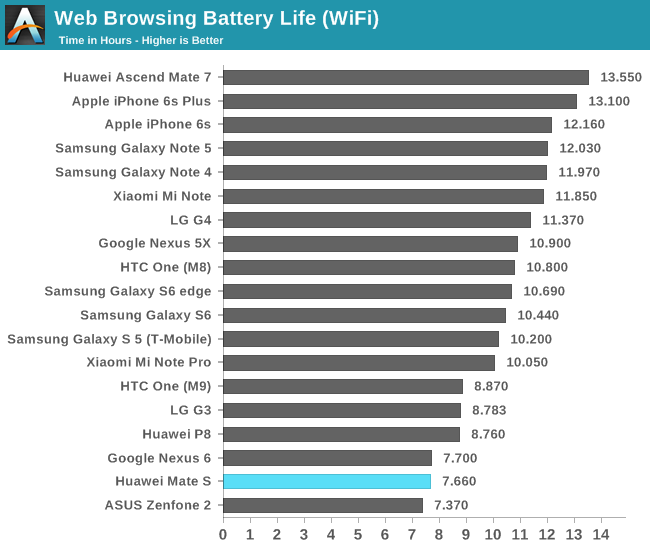
Starting with our web-browsing WiFi test we see the Mate S end up at 7.6h. Here we see the low power efficiency of the AMOLED screen affecting the device's battery life as web-sites are relatively high APL content and thus the almost 2x efficiency deficit over LCD screens is easily noticeable. Even though both devices sport a similar SoC, the P8 ends up almost an hour ahead of the Mate S.
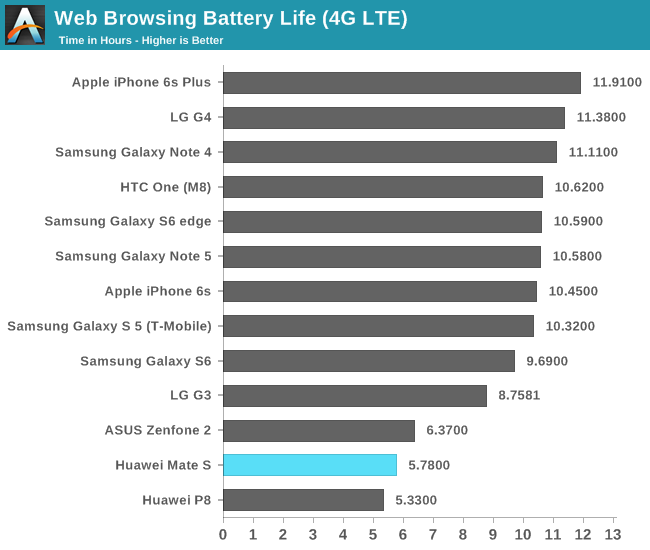
On the 4G test, I again have to remark that my testing conditions differ from our other mobile editors' and have to make due with relatively weak ~-96dBm LTE signals, increasing the power consumption of the RF system and making this a rather bad comparison between devices. Still, it's odd to see that the Mate S actually behaves better than the P8, as they're both tested under the same conditions. It may be that Huawei improved on the RF backend for the Mate S.
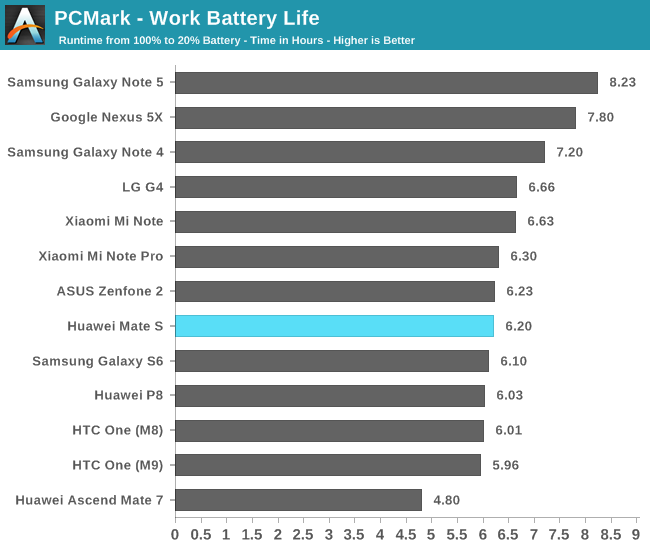
PCMark is a more balanced system benchmark that is not affected by the performance of the WiFi or cellular efficiency of the devices. Here the Mate S ends up with 6.2h runtime putting it in the middle-ground among other flagships.
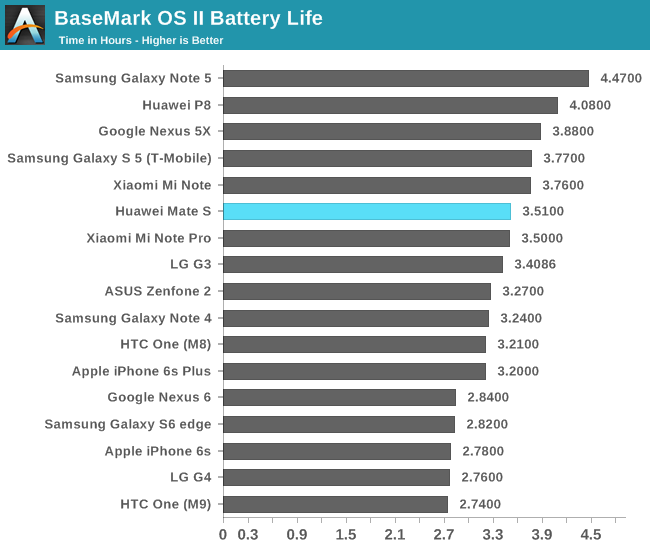
BaseMark OS II is a CPU stress test that is mostly TDP limited. Here the Kirin 930 manages to stay below other devices in terms of maximum power consumption, allowing it to achieve a runtime of 3.51h.
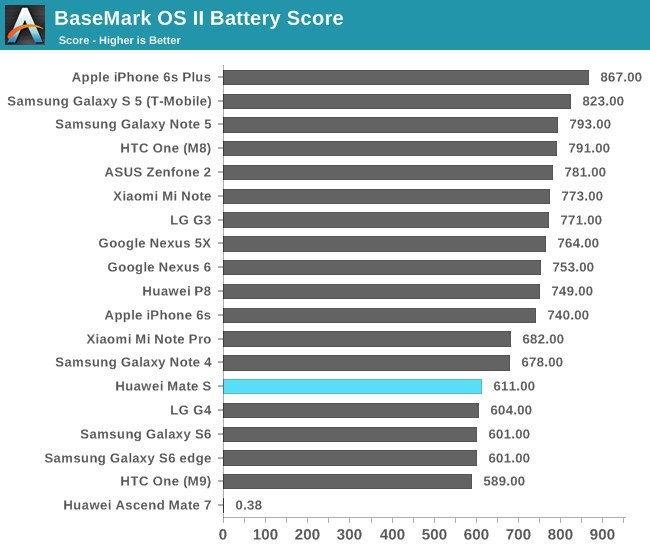
Of course we need to take account both the runtime and the amount of work done in the benchmark. Unfortunately while the 3.51h runtime is adequate, the A53 cores aren't performant enough to achieve a overall higher score which basically determines the overall productivity (efficiency) of the device.
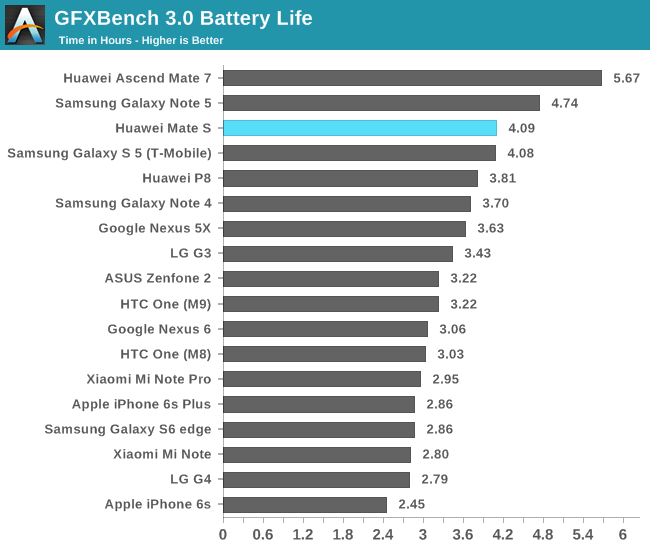
The Mate S behaves quite well in the GFXBench rundown, but only because it performs at much lower levels due to the thermal throttling that we indentified earlier in the GPU section. Here the AMOLED screen definitely helps the battery life of the phone as the T-Rex test is a rather low average picture level game benchmark.
Charging Time
An issue I brought up in our review of the P8 was that the review unit I received never came with the promised 10W charger that was mentioned during the initial device presentation, leading to the device having very slow charging behaviour no matter what charger I connected it to.
The Mate S fixes this issue as it does come with a 5V 2A default charger included. As seem in the charge graph, the battery cell gets charged at up to 7W in its fast-charging phase until it reases about 85% total charge. In half an hour the device is able to fill up to around 40% of charge, making this a quite reasonable charge rate.
Camera Still Picture Performance
The camera of the Mate S doesn't differ from the one on the P8, we again see usage of an F/2.0 optics module featuring Sony's IMX278 RGBW 13MP sensor, with the camera module also sporting two-axis optical image stabilization (OIS). Image processing is in part done by help of an external dedicated ISP by Altek.
Daytime Pictures
Overall the Mate S's daylight performance doesn't differ from what we've seen on the P8. This also comes with the same drawbacks that we've seen on the P8. The RGBW sensor's reduced resolution is worsened by the reduced clarity of details in objects such as leaves and greeneries brought by the fact that the sensor has only half the green sub-pixels compared to traditional Bayer RGBG sensors as found in other devices.
There were some instances where the Mate S did noticeably differ from the P8. Depending on lightning and subject, the Mate S was able to achieve better exposure and colour balance compared to the P8. This seems to be a result of improved calibration tables of the Mate S's post-processing and ISP. This was also one of the cases where the P8 seemed to have regressed compared to previous Huawei devices so I'm happy to see that the Mate S now is able to achieve comparable results to devices such as the Galaxy S6.
One aspect that Huawei still lags behind is usage auto-HDR mode that is able to choose whether it's best to use HDR or not. I found it quite tiresome to manually switch between the SDR and HDR modes to try to see which gave the best results. Unfortunately there's still instances where the Mate S's HDR mode might look too overexposed, resulting in unnatural images.
Nighttime Pictures
Nighttime differences between the Mate S and the P8 are much more noticeable. While the P8 struggled to properly capture the colour balance caused by the sodium lamps on the streets, the Mate S is able to do a much better job at reproducing the warmer scenes. An odd characteristic and regression on the Mate S in scene 1 was that the device wouldn't properly focus, resulting in some blurred out captures for that scenario.
In the last mixed-lightning scenario we see the Mate S again differ in terms of colour balance and slightly different exposure settings. Unfortunately this time around it's a regression compared to the P8 as it reproduces a too cold image compared to what we see on the P8 or Galaxy S6.
A new addition to Huawei's camera is a "Pro mode" with full manual controls. It allows for choosing between focus modes, an optional analog focus slider, exposure value from -2 to +2 E/V in steps of 0.1 or configuration of the shutter duration from 1/4000th to 8 seconds. ISO is configurable from ISO100 to ISO1600. What I also liked was besides the usual options of pre-configured white-balance presets also a full manual slider from 2800 to 7000K in 100K steps. All in all, this is a feature-complete camera application in terms of the most common manual controls. The device lacks the capability to shoot in RAW format, which is a pity. As for the interface itself, while it does look interesting in terms of design, it still falls behind in terms of usability compared to Samsung's pro mode and more imporantly, LG's pro-mode found on the G4 which I currently see as offering the most extensive and functional UI of any stock smartphone camera application.
Overall the Mate S camera is a good performer, but I wished there would have been more advancements in terms of image processing to achieve a more consistent camera performance. Huawei still lacks a proper auto-HDR option that is able to smartly choose between the two shooting modes, making everyday shooting requiring a little trial & error when trying to get the best shot out of a scene.
Video Performance
We've talked about the rather disappointing video performance of the P8 and deducted that this must be caused by the disappointing ISP and processing of the Kirin SoC. Since the Mate S sports the same hardware we unlikely to see much improvement in terms of video recording performance.
1080p30 - Optical image stabilization
The Mate S lacks 4K recording, so the video settings are best kept at 1080p with OIS always on. Huawei gives the rare option to turn off OIS but I've come to the conclusion that there is no real reason to disable it as it offers no advantage. EIS is still a no-go, as while doing a great job in terms of stabilization, it vastly reduces the effective resolution of the output stream resulting in much blurrier video that is simply no longer acceptable. Even with the optimal settings, the Mate S, similarly to past Huawei devices simply lacks sufficient detail to be able to compete against flagships from other manufacturers.
1080p videos are recorded at a bitrate of around ~9800kbps with a stereo 48KHz 96kbps AAC audio track. As with all previous Huawei devices I've review, the audio recording fidely is again among one of the best of any devices I've used with excellent clarity and stereo audio reproduction, so there's definitely praise to be had in that regard.
Conclusion
As we're coming to the conclusion, I'm left with mixed feelings in regards to the Mate S. In terms of design, this has been by far Huawei's best device to date. The vendor has managed to update or to improve in all aspects of phablet design: aesthetics, ergonomics and build quality. In terms of aesthetics, Huawei didn't veer off too much from their design language found in past devices. The Mate S is very much recognizable as being part of the Mate series, yet improves by doing little alterations such as the speaker repositioning or the new circular designs of the camera lens and fingerprint sensors. In terms of ergonomics the new more rounded design of the back along with the chamfered edges and 2.5D glass make this also Huawei's most comfortable phone to date.
One aspect that can't be shared with pictures and that is hard to describe is the phone's build quality. Gone are the plastic antenna covers found on the Mate 7 or the what seemed to be a very thinly built metal uni-body of the P8. The Mate S is among of the the most solid devices I've come across and seems to be worthy of being positioned in the premium flagship segment. In fact, during a group lunch on a recent Huawei media trip to China, were asked us what we thought was Huawei's best built device to date, and among all editors present at the table we all seemed to unanimously deemed this to be the Mate S.
So while there's a lot of praise in terms of the device's externals, it's also what is inside what matters. And here is where we discovered some worrying issues with the Mate S. First, bridging the external with the internals is the device's screen. While the new AMOLED screen brings large image quality improvements to Huawei's line-up, it's also lacking in accuracy and realistic colors. While this may be a subjective matter for a lot of users, and in fact there may very well be a lot of users who prefer the more saturated colors of the larger color gamut calibration, it's on the efficiency side where the Mate S's display panel drastically falls behind. Coming in at almost half the white luminance efficiency of a traditional LCD display, the device battery life suffers from employing what seems to be a cheaper and more inefficient AMOLED emitter material / panel.
In fact, it seems that the device's battery life is being hindered on three different fronts. Besides the inefficient display, the device sports a what is rather small 2700mAh battery for a 5.5" form factor device. The third factor is the Kirin 930 SoC. As detailed on the CPU power consumption section, the SoC seems to suffer from a rather worrying behavior due to an inefficient clocking architecture of the memory controllers. While the high clocked A53's perf/W efficiency curves don't fall all that far behind SoCs such as the Snapdragon 801, if one accounts the overhead due to the memory controller it brings it down to levels even below that of the Snapdragon 808 or 810 which is unfortunate. All in all, the Mate S is severely disappointing in terms of battery life.
In terms of performance, we actually saw some improvements due to the slightly higher clock of the CPU as well tweaking of the DVFS mechanisms. In every-day usage slow-downs are not noticeable although performance is also not too great and can't be compared to devices with more powerful SoCs. Consistently adequate would be a good term in defining the Mate S's performance. Of course this only applies to non-gaming performance as the device's GPU is very prone to throttling and again sports some unsatisfactory battery efficiency due to this fact.
Camera-wise the Mate S behaves a bit better than the P8 due to the improved behavior and white balance processing. Again, while this can be deemed a good camera, Huawei still has some work to do to make it as good as the competition's offerings. While I didn't write it up in a dedicated section, the Mate S is also plagued by extremely disappointing WiFi performance due to an aging BCM4334 WiFi chipset and bad antenna performance, which even lacks the capability for 5GHz bands that can be a deal-breaker for some consumers.
Software-wise, I don't have much to add as we didn't see many changes compared to the P8 or previous EmotionUI iterations. The task-switcher is still cumbersome and the device's application killing mechanisms such as the power-manager are a tad too aggressive and I wish the default settings would leave these options turned off. Otherwise I'm still very fond of EmotionUI's general aesthetics as it's one of the better looking OEM skins out there. The fingerprint sensor is among the best in the business and it also offers added functionality that we can't find on any other device.
This brings us back to my initial feeling of the device, which is say a mixed one. The Mate S is an extremely attractive device that easily holds up to the competition in terms of design and build-quality. Unfortunately the Mate S was launched a at a very high MSRP of 649€ for the 32GB version. Since then it seems the price has fallen to about 500-550€ at the time of writing, which is still a considerable amount. Here's where we fall back to the question as to why the Mate S came to be in the first place. What seems to have happened is the Mate 8 couldn't make the usual September launch due to the Kirin 950 not being ready for manufacturing, so Huawei managed to create a off-shoot of the Mate series as a stop-gap solution.
In the end I'm not sure if that was all that great of a decision for costumers as the Mate S carries a lot of the more crippling aspects of previous Huawei flagships. The big "killer" feature of the Mate S was supposed to be the touted force-touch capability, but with that variant of the phone not being released until next year it leaves the rest of the lineup with sort of a lack of direction and purpose. A SoC is crucial to the performance and efficiency of a device and HiSilicon's offerings were simply not as competitive compared to chipsets from Qualcomm or Samsung. I can't help but think that this would have been a great device if Huawei had opted for a higher efficiency screen and also waited until the Kirin 950 was ready. Unfortunately that's not how it played out and thus I would rather recommend for users to wait for the Mate 8, or if that form factor is too big, to look at other competing devices. Still, Huawei is moving forward one step at a time with great potential and I'm looking forward to their next device.

